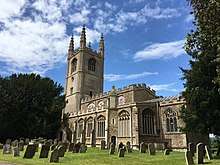All Saints Church, Conington
All Saints Church is a redundant Anglican church in the village of Conington in the Huntingdonshire district of Cambridgeshire, England. It is recorded in the National Heritage List for England as a designated Grade I listed building,[1] and is under the care of the Churches Conservation Trust.[2] The church stands to the east of the village, between the A1 road and the East Coast Main Line.[2][3]
| All Saints Church, Conington | |
|---|---|
 All Saints Church, Conington, from the south-east | |
 All Saints Church, Conington Location in Cambridgeshire | |
| OS grid reference | TL 179 858 |
| Location | Conington, Cambridgeshire |
| Country | England |
| Denomination | Anglican |
| Website | Churches Conservation Trust |
| Architecture | |
| Functional status | Redundant |
| Heritage designation | Grade I |
| Designated | 28 January 1958 |
| Architectural type | Church |
| Style | Gothic |
| Specifications | |
| Materials | Limestone and fieldstone |
History
A church was mentioned in the Domesday Survey.[4] It was rebuilt in about 1500. The embattled parapets were restored in 1638 by Sir Thomas Cotton. In 1841 the church was restored and the pews were replaced. A new east window was added in 1852. The tower was strengthened in 1862, and further repairs were undertaken between 1897 and 1899.[4]
Architecture
Exterior
All Saints is constructed in limestone rubble and fieldstone, with limestone dressings.[1] Its plan consists of a four-bay nave with a clerestory, north and south aisles with chapels at their east ends, a chancel, north and south porches, and a west tower.[1][4] At the east end of the south aisle is a chapel. The tower is in four stages on a plinth decorated with quatrefoil ornament. At the corners are half-octagonal turrets rising to crocketted pinnacles. The parapet is battlemented with a quatrefoil frieze and gargoyles at the centre of each side. In the bottom stage is a west arched doorway, above which is five-light window. The bell openings in the top stage have four lights. The clerestory has three three-light windows and one five-light window on each side. Along the side of the south aisle are three four-light windows. The south chapel has a four-light south window, and a five-light east window. Between the aisle and the chapel is a rood turret with a polygonal roof and a foliated finial. The south porch is shallow and gabled with a tiled roof. The chancel has three-light windows in the north and south walls and a restored east window.[1]
Interior
Inside the church are four-bay arcades, the westernmost bays being wider than the others. In the south wall of the chancel is a three-seat sedilia and a piscina. The limestone octagonal font dates from the 15th century, and stands on a 19th-century base. In the church are monuments to the Cotton and Heathcote families.[1] Most of the furnishings date from 1841.[2] The organ was built by Miller and Son of Cambridge.[5] There is a ring of six bells, all cast by Thomas Mears II of the Whitechapel Bell Foundry, five of them in 1827, and the sixth in 1834.[6]
References
- Historic England, "Church of All Saints, Conington (1162630)", National Heritage List for England, retrieved 27 June 2013
- All Saints' Church, Conington, Cambridgeshire, Churches Conservation Trust, retrieved 9 December 2016
- Conington, Streetmap, retrieved 7 March 2011
- Conington: Church History, GENUKI, retrieved 7 March 2011
- Huntingdonshire (Cambridgeshire), Conington Nr. Sawtry, All Saints (N03110), British Institute of Organ Studies, retrieved 7 March 2011
- Conington All Saints, Dove's Guide for Church Bell Ringers, retrieved 7 March 2011